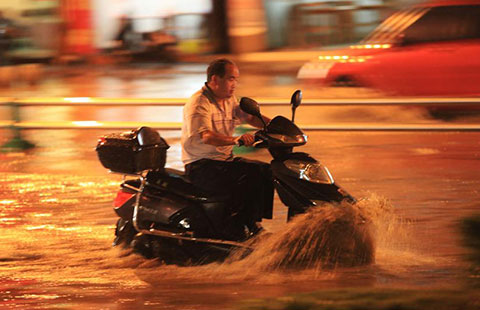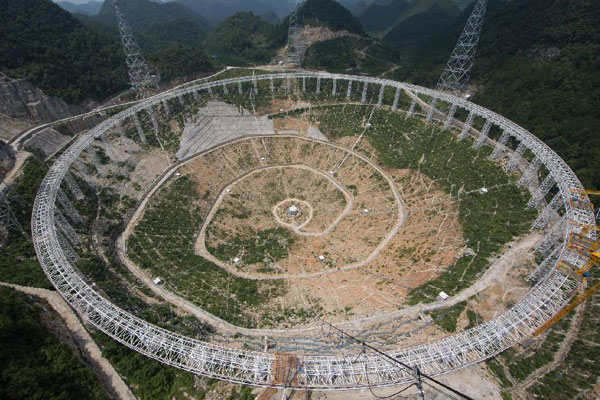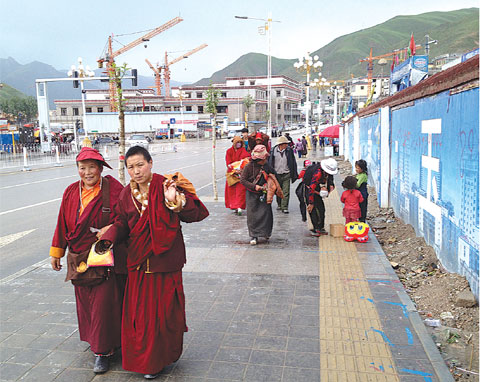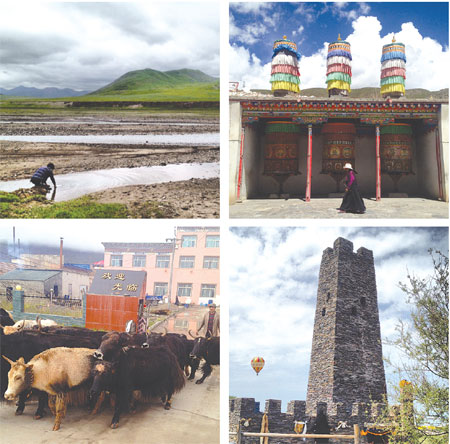The jade tree branches out
Updated: 2015-07-31 16:36
By Erik Nilsson(China Daily USA)
|
|||||||||
Following the 2010 quake and fledgling Belt and Road Initiative, Yushu is courting tourists to improve Tibetan nomads' livelihoods
A car crunches into a yak, destroying both.
The driver confronts the herdsman: "Why'd you guide your yak on the road? There's no grass on it!"
The nomad retorts: "Why'd you drive your car over my yak? There's no pavement on it!"
So goes a joke in Qinghai province's Yushu autonomous Tibetan prefecture.
For good reason. Traffic jams' triggers are more likely to have hooves than wheels.
And be steered with "Tibetan guns" - that is, slingshots used to herd.
This is yak country.
That's not to mention the perpetual pinball game of pikas that make every rural road a gauntlet. Drivers veer to try to miss them - "try" being the operative word - adding zigs and zags to rides outside downtown.
One night, a wolf flashed in of our headlights. Our brights cast him in ghostly illumination and made his eyes burn neon.
My first year visiting Yushu's hinterlands, 2011, we stopped to help when we saw an upside-down car. Last year, we saw a coal truck on its side, spilling black nuggets down the mountainside. The driver paced atop the overturned truck's side, clasping a cellphone to his ear.
I can only imagine the conversation he was having.
Piles of stones mark fatal crashes' locations.
They're essentially "slow-down" signs without words.
But roads have continued improving since the 2010 quake pushed the government to invest in transportation and tourism. And the Belt and Road Initiative is paving ways toward better motorways.
Driving progress
"Highways and railways to major scenic sites will be built, environmental-impact studies pending," says a Yushu tourism department public relations official, who'd only give his surname, An.
Plans call for linking Yushu to the high-speed rail system within five years, An says.
Flights connecting to the Tibet autonomous region's Lhasa, Sichuan province's Kangding county and Yunnan province's Shangri-la will begin within three years to expand tourism, Xinhua News Agency reports.
Low-altitude air routes, covering such scenic spots as the origins of the Yellow and Lantsang rivers, are also in the works, Xinhua quotes Liu Lizhi, director of the prefecture's culture-and tourism-integration development office, as saying. These are expected to chop travel times from between three and six hours to half an hour.
This comes as the city hopes to shepherd its economy away from herding and toward tourism. Husbandry generates little revenue despite intensive labor and has recently been restricted to curb desertification.
Much of the 100 million yuan ($16 million) the central government earmarked for Yushu's development during the 2011-14 period has been used to restore scenic sites and roads damaged in the disaster, says an official surnamed Zhao, with the Qinghai tourism bureau's planning and development department.
The provincial government last year announced plans to disburse 10 million yuan annually from the local tourism fund to build toilets and parking lots, and stage festivals, Zhao says. The money will also pay for personnel training and museum construction.
A tourism-service center will be completed this year to assist travelers and employ locals, she says.
About 120,000 visitors arrived in Yushu in the first half of this year, a 30 percent increase over the same period in 2014. Revenue increased 16 percent to 60 million yuan, An says.
Yushu's tourism department ambitiously aspires to this year lure 480,000 tourists, whom they hope will generate 200 million yuan, An says.
Taxi driver Xiao Mei says he moved to Yushu from his native Sichuan's capital, Chengdu, to cash in on the tourism boom.
"The only work here was husbandry and harvesting caterpillar fungus," he says.
"Tourism has brought more jobs. Like mine."
Silk Road journeys
Yushu hopes to diversify not only its tourism but also its tourists.
Foreign visitors have accounted for a slender sliver of the pie.
Qinghai's tourism bureau has this year worked with the China National Tourism Administration - which named 2015 the Year of Silk Road Travel - to run promotions in such Silk Road countries as Kazakhstan, Turkey and Italy. It recently signed a cooperation agreement with Italy's Lombardy, Zhao says.
The prefecture's tourism bureau has also inked a deal with Nepal in which Nepalese craftspeople will design Buddhist figurines and souvenirs with Yushu essences, An says.
Yushu's history as an ancient Silk Road hub is injecting new vigor into its contemporary allure for international travelers.
It was a trade node connecting Sichuan, Gansu and Tibet. And it was a vital stop on the Tangbo pass, through which Tang Dynasty (AD 618-907) princess Wencheng journeyed to Tibet to marry a local king to enrich political unity. She's credited with bringing Buddhism to Tibet.
Her legacy remains not only as a cultural emblem but also in physical forms - as a plethora of pagodas and especially as the Princess Wencheng Temple, known as Nampa Nangze in Tibetan.
White stupas and red buildings grip rocky ridges, slung with superlatively lengthy strings of prayer flags. These also span the crests between peaks, forging flittering rainbows connecting Heaven and Earth - metaphorically and physically, materially and spiritually.
Pilgrims slog up the mountainsides to circle the temple clockwise.
Cultural charisma
While less historically significant, more visually resplendent are the Gyani Mani Stone Walls - a Technicolor labyrinth of an estimated 2.5 billion painted rocks, etched with holy symbols, piled into ramparts.
It's said to be the world's largest mani structure.
It took about three years after the quake to reconfigure the stacks amassed over three centuries. Today, pilgrims, monks, alms-seekers and the occasional lost yak take sacred steps through the dizzying arrangements of polychrome stones.
Craftspeople chisel rocks behind the complex with cacophonous staccatos of "crack, thwack, smack!" that echo off the mountains. They unintentionally play percussion for the pilgrimages inside.
Embedded within the maze are rows of prayer wheels, stupas and religious buildings. Looming poles that radiate prayer flags serve as beacon towers to orient pilgrims, who often start in the center and spiral outward, clockwise.
While the mani walls can prove puzzling, Jyekundo Dondrubling Monastery helps visitors position themselves within Yushu, as the mountaintop temple provides a bird's-eye panorama of the prefecture seat.
Yet non-Buddhist travelers find Yushu's constellations of holy sites to be a sideshow to the circus that is the annual horse festival, which runs from July 25-28.
Nomads and tourists camp on the grasslands that sparkle with colorful prairie flowers to witness horseback riding, archery and wrestling feats.
Tibetans also stage yak dances - equivalents of the ethnic Han's lion dances.
The celebration lured about 100,000 visitors last year and the year before. Officials expect an upsurge this year.
The festival is purposefully timed. July is the warmest month.
Elevations averaging 4,200 meters mean it snows 10 months a year. (While the settlement's name translates as "jade tree", there isn't a tree for hundreds of km because of the altitude.)
The best period to travel visit is from June to October.
Otherwise, flurries make the roads even rougher.
But while transportation improves and fewer livestock rove the roads, locals assure me the jest about the smashed yak will get yuks for years to come.
"It's part of our culture," a local teacher explains.
"Things change. But we'll always love yaks - and to laugh."
Yang Feiyue contributed to this story.
|
Monks and herders walk in front of cranes in Qinghai province's Yushu Tibetan autonomous prefecture, following the 2010 earthquake. The prefecture is not only rebuilding its infrastructure but also reconstructing its identity as a tourismdestination to shift its economy away fromhusbandry. Photosby Erik Nilsson / China Daily |
|
Clockwise fromtop left: A driver dips a bottle into a creek to pour water on his truck's overheating axle as he navigates Yushu's remote roads in 2014; a pilgrim walks in front of prayer wheels in Yushu's GyaniMani StoneWalls; a hotair balloon rises over Qinghai Lake near the provincial capital, Xining, behind a Tibetan stone tower adorned with animal skulls and pelts in 2013; aman guides yaks through a hotel parking lot in downtown Qumalai county, Yushu, in 2014. |

(China Daily USA 07/31/2015 page5)
- 38.7b yuan in State assets recovered in campaign
- China closely watches recovery of Boeing debris: spokesman
- Netizens question narrative of human trafficking victim turned model teacher
- Jing-Jin-Ji project gathers momentum as young people return
- Only living panda triplets celebrate first birthday
- Mother's death prompts escalator safety campaign

 Top 10 international destinations for Chinese millionaires
Top 10 international destinations for Chinese millionaires
 Rainstorm affects 940,000 in South China
Rainstorm affects 940,000 in South China
 Do you take all your paid leave?
Do you take all your paid leave?
 National Art Museum of China displays Polish folk art
National Art Museum of China displays Polish folk art
 Chinese soldiers in parades
Chinese soldiers in parades
 US Marines Corpos soldiers demonstrate martial arts
US Marines Corpos soldiers demonstrate martial arts
 World's largest radio telescope being built
World's largest radio telescope being built Elvis Festival pays tribute to the King of Rock 'n' Roll
Elvis Festival pays tribute to the King of Rock 'n' Roll
Most Viewed
Editor's Picks

|

|

|

|

|

|
Today's Top News
Chinese defense concerned about US moves in South China Sea
Chinese named in test-taking scam deported from US
Baidu to buy back shares worth $1b
Former military leader Guo Boxiong expelled from CPC, to face justice
Pair to face poaching charges related to death of popular lion
Amazon wants air space for delivery drones
Embassy continues its work in aftermath of car bombing
Netizens pack heavy wallets
US Weekly

|

|









